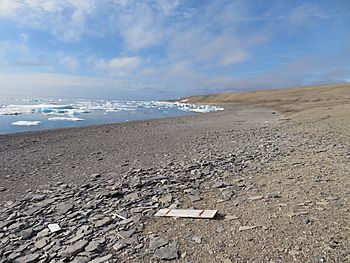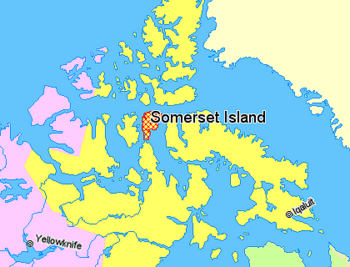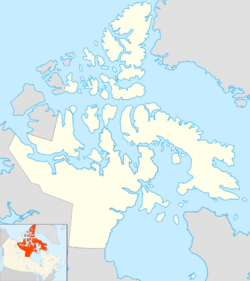Somerset Island (Nunavut) facts for kids
|
Native name:
Kuuganajuk
|
|
|---|---|
 |
|

Somerset Island, Nunavut, Canada
|
|
| Geography | |
| Location | Northern Canada |
| Coordinates | 73°15′N 93°30′W / 73.250°N 93.500°W |
| Archipelago | Canadian Arctic Archipelago |
| Area | 24,786 km2 (9,570 sq mi) |
| Area rank | 46th |
| Highest elevation | 489 m (1,604 ft) |
| Highest point | Creswell Peak |
| Administration | |
|
Canada
|
|
| Territory | Nunavut |
| Region | Qikiqtaaluk |
| Demographics | |
| Population | Uninhabited |
Somerset Island, known as Kuuganajuk in Inuktitut, is a very large island in the Canadian Arctic Archipelago. It is an uninhabited island, meaning no people live there permanently. The island is located in the Qikiqtaaluk Region of Nunavut, Canada.
Somerset Island is separated from the Boothia Peninsula by the Bellot Strait, which is about 2 kilometers (1.2 miles) wide. It lies between Peel Sound and Prince Regent Inlet. Across Peel Sound is Prince of Wales Island, and across Prince Regent Inlet is Baffin Island. With an area of 24,786 square kilometers (9,570 square miles), Somerset Island is the 46th largest island in the world and Canada's twelfth largest island.
Contents
Exploring Somerset Island's Past
Ancient Life on Somerset Island
Around 1000 AD, the northern coast of Somerset Island was home to the Thule people. We know this because archaeologists have found old whale bones, tunnels, and stone ruins there. These findings show that people lived and hunted on the island long ago.
First European Sightings
The first European to see Somerset Island was William Edward Parry in 1819. He was an explorer on a journey through the Arctic.
The Story of HMS Fury
In 1825, an Arctic exploration ship called HMS Fury got stuck in the ice. The ship, commanded by Henry Parkyns Hoppner, had to be abandoned on August 25, 1825. The place where it was left is now called Fury Beach on Somerset Island. The ship's supplies were unloaded onto the beach. Years later, these supplies helped another explorer, John Ross, who had lost his own ship further south. Ross and his crew traveled overland to the abandoned supplies, which saved them.
James Clark Ross's Expedition
James Clark Ross was John Ross's nephew and joined him on the 1829 expedition. In late 1848, James Clark Ross returned to Somerset Island. He landed two ships at Port Leopold on the northeast coast to spend the winter. The next spring, in April, he explored the island using sledges.
Sailing the Northwest Passage
The passage between Somerset Island and Prince of Wales Island is part of the famous Northwest Passage. In 1904, Roald Amundsen successfully sailed through this passage in his ship, the Gjøa. This was the first time anyone had successfully traveled the entire Northwest Passage.
Later, in 1943, Henry Larsen also sailed through the passage in his ship, the St. Roch. This was the second successful trip. However, Larsen found this route very dangerous due to thick ice. He also noted it was too shallow for large commercial ships.
The Fort Ross Trading Post
From 1937 to 1948, the Hudson's Bay Company ran a trading post called Fort Ross on the southeastern end of Somerset Island. When the post closed in 1948, the island became mostly uninhabited. Sometimes, Inuit hunters from Taloyoak would use the old store and manager's house as shelters while hunting caribou.
A small settlement also existed at Creswell Bay. After 1967, only the family of Timothy Idlout and Naomi Nangat lived there. The Idlout family left Somerset Island in 1991, making the island completely uninhabited. In 2006, CBC News featured Fort Ross in a special series about climate change.
Visiting Somerset Island Today
Arctic Watch Lodge: A Place for Adventure
Today, Somerset Island is a destination for adventure tourism. The Arctic Watch Lodge, built in 1992, is a special place for visitors. It is located at Cunningham Inlet. This area is popular because many beluga whales gather there during the summer months.
The Arctic Watch Lodge is run by Richard Weber and Josée Auclair, who are both explorers. The lodge has its own private airstrip, called the Arctic Watch Lodge Aerodrome, making it easier for visitors to arrive.
See also
 In Spanish: Isla Somerset para niños
In Spanish: Isla Somerset para niños




